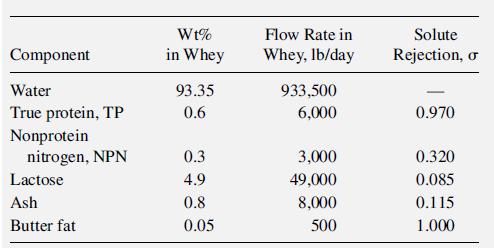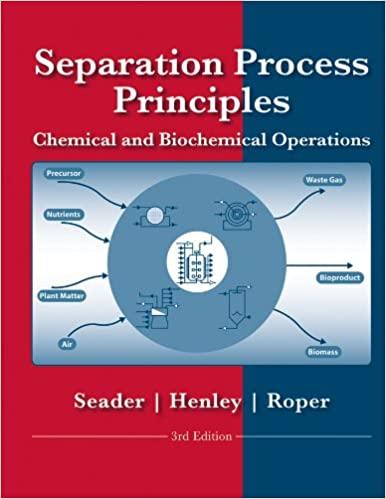Based on the problem statement of Example 14.20, calculate for just Section 1 the component material balance
Question:
Based on the problem statement of Example 14.20, calculate for just Section 1 the component material balance in pounds per day of operation, the percent recovery (yield) from the whey of the TP and NPN in the final concentrate, and the number of cartridges required if two stages are used instead of four.
Example 14.20
A cheese plant produces a byproduct stream of 1,000,000 lb/day of whey, to be further processed to obtain a dry powder containing 85 wt% combined TP (true protein) and NPN (nonprotein nitrogen compounds). The process includes three sections:
(1) Four stages of continuous bleed-and-feed ultrafiltration to reach 55 wt% (dry basis), followed by
(2) Four stages of continuous diafiltration to reach 75 wt% (dry basis), followed by
(3) One stage of batch diafiltration to reach the final 85 wt% (dry basis), with a batch-time limit of 4 hours. Diafiltration must be used above 55 wt% because the retentate from UF becomes too viscous. Each section will use PM 10 ultrafiltration hollow-fiber membrane cartridges from Koch Membrane Systems, which are 3 inches in diameter by 40 inches long, with 26.5 ft2 of membrane area, at a cost of $200.00 each. For each cartridge, the recirculation (recycle) rate is 23 gpm. The number of cartridges is to be the same in each stage for Sections 1 and 2. The inlet pressure to each is 30 psig, with a crossflow pressure drop of 15 psi and a permeate pressure of 5 psig. For these conditions, the membrane flux has been measured for the whey and correlated as a function of the concentration factor, CF, by:
![]()
where CF, for any stage n, is defined by reference to the fresh feed to Section 1, as
![]()
Whey composition and membrane–solute rejections, σ, are:

Based on s values, the membrane increases the concentration of TP while selectively removing the low-MW solutes of lactose and ash. Whey and all retentate and permeate streams have a density of 8.5 lb/gal. The continuous sections of the process will operate 20 hr/day, leaving 4 hr/day to remove accumulated membrane foulants and sterilize equipment. For each section, calculate:
(1) Component material balances in lb/day of operation, including dilution water for diafiltration;
(2) Percent recovery from whey of TP and NPN in the intermediate and final 85 wt% concentrate; and
(3) Number of membrane cartridges. Also, for Section 1, make calculations for a single continuous stage, compare results to those for four stages, and discuss advantages and disadvantages of four stages versus one stage.
Step by Step Answer:

Separation Process Principles Chemical And Biochemical Principles
ISBN: 9780470481837
3rd Edition
Authors: By J. D. Seader, Ernest J. Henley, D. Keith Roper





